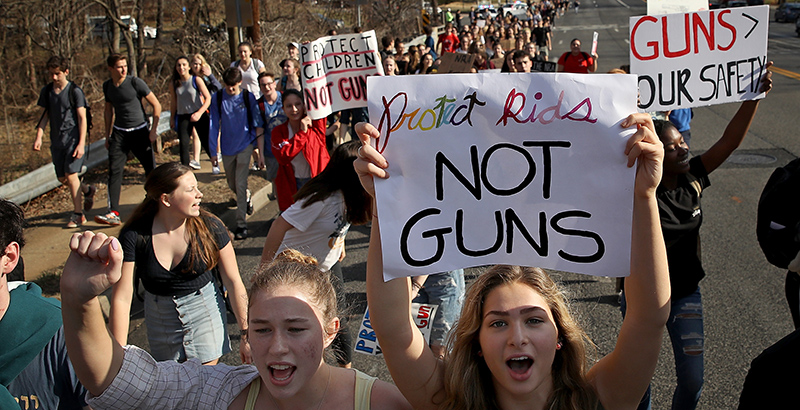School Safety Tops Young People’s List of Election Concerns. But Will It Lead Them to Vote?

Baltimore
The February school shooting in Parkland, Florida, and subsequent student activism around school safety and gun control are fueling young people’s political engagement ahead of next week’s midterm elections.
“We can argue all we want, but the only way we win the argument [for more gun control] is when we go and we vote on these decisions,” Mei-Ling Ho-Shing, a senior at Marjory Stoneman Douglas High School, said at a conference Friday.
Ho-Shing and eight other high school student activists from around the country spoke on a panel during the Council of the Great City Schools’ annual conference in Baltimore days ahead of a new poll confirming the strong link between the Parkland shooting and the civic engagement of students. A study released Monday from the Education Week Research Center found that 40 percent of the youngest eligible voters, those ages 18 and 19, cited the Florida shooting as having quite a lot or a great deal of influence on their political engagement. It tied with “reaching the voting age,” and edged out President Trump and his administration as drivers of engagement, the study found.
However, the Baltimore forum and a spate of youth-focused polls offered some mixed signals about whether students of voting age would show up to the polls next week in any large numbers.
Students have led a wave of activism in the eight months since the Parkland shooting, including a national school walkout and the March for Our Lives in Washington. Leaders of the movement from Marjory Stoneman Douglas High School led a national bus tour this summer to register young voters, and a group of students last weekend wrote a School Safety Bill of Rights calling for better mental health care in schools and gun control reforms.
On school safety questions, the students at the Baltimore conference were generally, though not universally, opposed to increasing the number of metal detectors, school safety officers, and other common security measures on campus.
“We should always be empowering our students, not disenfranchising them. More guns has never been the solution to any problem,” said Esther Ubadigbo, a junior at Roosevelt High School in Des Moines, Iowa, said of arming teachers, another proposed solution to school shootings.
Beyond gun issues and school safety, they discussed their concerns with the environment, immigration, the MeToo movement, and lowering the voting age.
The student panelists’ concerns about school safety and gun control are also reflected in broader public opinion polls of young voters.
In the Education Week survey, which was funded by the Education Writers Association, 15 percent of young people cited either school safety (8 percent) or gun control (7 percent) as the most important social problem facing the country. They were the most cited concerns among a long list, above issues like terrorism (4 percent) or health care (3 percent).
A separate study released last week of a broader group of young people also found a high degree of concern about guns: two-thirds of voters ages 18 to 29 said school shootings are one of the most important issues facing America, and 70 percent said gun laws in America should be more strict.
That’s similar to the general population: 68 percent of people surveyed by Pew in September said gun policy was a “very important” issue affecting their votes this fall, close behind Supreme Court appointments (the poll was conducted in the midst of the confirmation fight for now-Justice Brett Kavanaugh), health care, and the economy.
Despite the walkouts and increased media presence of student activists, the leaders at the Baltimore conference, most of whom aren’t yet old enough to vote, weren’t particularly optimistic that their slightly older peers would turn up at the polls next week.
“We tend to represent a very small amount of students that are civically engaged,” Nick Paesler, a senior at Cleveland High School in Portland, Oregon, told the conference. “Students don’t really see how their voice and their vote can make a difference.”
Some of the students on the panel said there isn’t a larger youth voting movement because there isn’t one bipartisan issue that unites young people’s advocacy, like ending the Vietnam War or lowering the voting age did in the 1970s.
Others said it’s because those in power make decisions that ignore the voice of young people.
“We see everything in our country and we think, or I think, ‘Man, our country really doesn’t care about me,’” Kay Galarza, a student in New York City, said. “Our country either doesn’t see us, or hears us but decides to silence us even further.”
The Education Week study, which surveyed just the youngest eligible voters, found very different results: nearly two-thirds of respondents said they plan to vote.
But there is cause for a high degree of skepticism. If anywhere even close to the 63 percent of those young people actually vote, it would be a historic high. No more than 20 percent of Americans ages 18 to 24 have turned out in any midterm election in the past 20 years, according to the U.S. Census. In 2014, the turnout was particularly low for that age group, just 15.9 percent.
Other surveys predict far less robust participation by young voters: a June poll found that just 28 percent of those 18 to 29 said they are “absolutely certain” they’ll vote next week.
Get stories like these delivered straight to your inbox. Sign up for The 74 Newsletter

;)
